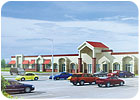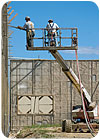
For 35 years contractor and inventor Pete Konopka has been pursuing the Holy Grail of modern buildings– a “zero-net-energy” structure that provides all of its own energy onsite and is not dependent on the electrical grid for ANY electricity–and is convinced he’s on the brink of success.
“I’m going to build the first zero-net-energy building in Chicago,” Konopka confidently told Walls & Ceilings during a tour of a suburban Chicago construction site where his crew was erecting a 22,750 square-foot commercial building using a unique SIPs-style system that he has been perfecting for decades, called Solarcrete.
Konopka has already built a massive commercial building–13 acres under one roof in suburban Chicago–that is nearly “net-zero” since it does not have a single heater or air conditioner on the premises. Nevertheless, for eight years it has kept the 125 employees who work there comfortable all year long, even when the outside temperatures hit 10 below zero or 110 F. So, he’s more than confident there is only one “piece of the puzzle” left before he stands at the highest summit of success for “green” building. He’s now in negotiations to acquire that final piece from several American manufacturers.

60-90 PERCENT EFFICIENT
Even though Konopka has built more than 440 buildings using the Solarcrete system, few people outside of the Midwest know about the process, or of its breathtaking energy efficiency, 60-90 percent, depending on a range of factors. There are other licensed Solarcrete contractors/dealers, who operate mostly in Ohio. Konopka is half-owner of National Solarcrete as well as the licensee for Chicago and environs, where he has lived his whole life.Solarcrete buildings, even single-family homes and apartment buildings, look pretty much like other buildings, but they have seamless walls one-foot thick: 7 1/2-inches of EPS foam is sandwiched between 2 3/8 inches of reinforced concrete inside and out, for an R-value of 40. The superstructure of the wall is prefabricated out of foam and metal in Solarcrete’s factory, and then assembled on-site using a specialized latching process. The panels are 4 feet wide and include precision-engineered cutouts for doors, windows, wiring and plumbing. The panels are foam surrounded by a “cage” of galvanized wire and re-bar. Once erected on foundations usually 48 inches below grade, the panels are covered with three layers of “shotcrete.”
“Shotcrete is the term for blowing wet cement,” Konopka explained. “We apply a thin coat first, then a second, and a third, with a nozzle that shoots the concrete at 125 psi.” Expansion joints serve as screeds to get the 2 3/8-inch thickness of concrete, and then highly skilled craftsmen work the concrete first with trowels, then a wet sponge to get a smooth stucco finish. Most of the work on-site is done by two-man crews operating on hydraulic platforms, adding an amazing visual dimension of complexity to the process. The final exterior surface of Solarcrete buildings is typically an elastomeric compound similar to those used with EIFS. Interior walls can merely be painted, or covered with drywall, applied either on the concrete itself, or on furring strips.
On a recent hot summer day there were three two-man crews working from separate hydraulic lifts on a 100- x 400-foot building with walls 26 feet high. One crew was tightening wire and rebar on the last side of the building that had not yet been sprayed with concrete, one crew was spraying concrete on various sections, and the third crew was smoothing the concrete to achieve the final surface.

Crews in the air, on the ground
Meanwhile, at least five men were assisting in various tasks on the ground, from manning the spray-pump and overseeing the pouring of concrete, to cleaning expansion joints. Most of the Solarcrete employees have been with the firm between five and 10 years, and are routinely trained in all phases of the operation, including constructing the pre-fab panels in the factory.While Konopka stressed that there are certain trade secrets regarding the mix of the concrete and the construction of the panels, there is much about Solarcrete that is decidedly not secret. He’s been gearing up since last spring to tell the world about it, beginning with hiring a full-time director of marketing, Rob Kayser.
The first thing Konopka is eager to discuss is the energy efficiency of the Solarcrete system, and he admits he sounds a tad fanatical about it, especially when he mentions the inevitability of legislation that will force the LEEDS-type standards on the whole American construction industry. Like any entrepreneur, he insists he doesn’t like government regulation, but sees construction in the same predicament the auto industry was in decades ago on safety belts, airbags and other enhancements about which automakers now boast. Government stepped in when the industry wouldn’t.
The way Konopka sees it, it’s utter lunacy that Americans are buying buildings-especially large commercial “big box” retail stores–that are virtually radiators, and he can’t figure out why more contractors don’t “go green.” He blames a corporate culture that does not reward building efficiency: The general contractor is paid to build inexpensively, by an owner who leases to a company that need not be concerned at all about utility costs because these expenses will be passed on to customers.
But for those who do care– typically small business owners who have to pay the energy bills themselves–Konopka has certainly been doing his part to move the industry along, continually refining the Solarcrete system to make it more efficient and easier for contractors to install.
He once had thermographic images taken of his buildings and noticed that there were “tiny red dots” all over the place. That’s a bad thing, because heat was leaking out of the building in these areas, which represented steel tie-bars deep in the concrete used to keep the pre-fab panels together. So Konopka designed and patented a sturdy plastic unit that works just as well, with absolutely no heat loss.
Satisfied customers
In some respects Solarcrete’s Marketing man Kayser’s job isn’t that difficult, since satisfied Solarcrete customers seem to be eager to do some heavy lifting in promoting Solarcrete. Consider the case of Tony Jedinski, vice president of operations for Roman Inc., a giftware distributor in northern Chicago who bought his first Solarcrete building, a big new distribution center in Roselle, Ill., 22 years ago.He learned of Solarcrete only because his son happened to go to the same elementary school with the son of Eric Bode, co-inventor of the Solarcrete system. One day Jedinski mentioned he was in need of a new building and Bode convinced him to try the Solarcrete system. Two decades and two additional Solarcrete buildings later, Jedinski said he scratches his head, wondering: “Why isn’t everyone doing this?”
Jedinski’s first Solarcrete building was completed in 1987. It is 300 x 400 feet with walls 26 feet high, and a second floor for offices with 40,000 square feet. Jedinski’s only regret is that he had a furnace and air conditioner installed, even though other Solarcrete building owners said he’d basically be wasting his money on the ductwork and machinery. “I didn’t want to take a chance at not putting in any air and heating equipment,” he said. “It’s amazing, but in 17 years, we’ve never used it.”
Jedinski is most delighted that the money saved on energy bills paid off the building in 17 years, so it was an easy decision to use Solarcrete in 1999 when his firm decided to build a 1,000 x 500 foot distribution center in Addison, Ill. The walls soar to 36 feet, and the square footage of the roof is the equivalent of more than 12 football fields.
“When I built the Addison building I said ‘we’re not going to spend a penny on heating and cooling.’” He did, nevertheless, have a natural gas line connected for the hot water heater, to serve the needs of his 125 employees. “I love it when the gas company comes out and investigates because they can’t figure out how I’m ‘stealing gas’ to heat the place,” Jedinski laughed as he told the story. He acknowledged, however, that in the enclosed office spaces humidity was a problem at first, but that was simply managed by resetting the dehumidifier to run less often than the factory-installed circuitry calls for.
CALCULATING SAVINGS
Jedinski is an electrical engineer and worked with Konopka to create an online energy calculator database, which shows savings in Solarcrate vs. traditional buildings. “The savings are in the tens of thousands of dollars per year. How can you not look at something like that?” he asked.Konopka explained why the Solarcrete system works so well: “When we go three feet below the frost line we create a thermal cave, where temperatures are stabilized. There is less of a variation in temperatures internally, thus it is a lot less expensive to heat the building. We also recommend certain windows, skylights, and so on. We want to be as energy efficient as possible and want the building to be paid off as soon as possible.”
“The way to look at it is as if the building is an insulated cooler,” Kayser said. “If you put it over the ground, the main thing that is providing heating or cooling is the ground, which is at 53 degrees, and that never changes.”
Konopka is convinced that the final “piece of the puzzle” to getting a “zero-net-energy” is installing an effective photovoltaic cell (PV) that will turn solar energy into electricity. He can barely contain himself as he explains that he’s in discussions with some manufacturers, who are advertising PV cells that look very similar to traditional shingles.
And for his part, Kayser said he’s been getting excellent responses in his talks to local business groups and other organizations about “green building,” especially when he mentions that the best part of “going green” is “keeping our money at home. We don’t have to spend our money to buy oil from countries that are our enemies.”



